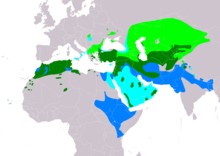| Long-legged buzzard | |
|---|---|

| |
| Scientific classification | |
| Domain: | Eukaryota |
| Kingdom: | Animalia |
| Phylum: | Chordata |
| Class: | Aves |
| Order: | Accipitriformes |
| Family: | Accipitridae |
| Genus: | Buteo |
| Species: | B. rufinus
|
| Binomial name | |
| Buteo rufinus (Cretzschmar, 1829)
| |
| Subspecies[2] | |
| |

| |
| Range of B. rufinus Breeding Resident Passage Non-breeding
| |
| Synonyms | |
| |
The long-legged buzzard (Buteo rufinus) is a bird of prey found widely in several parts of Eurasia and in North Africa.[1] This species ranges from Southeastern Europe down to East Africa to the northern part of the Indian subcontinent.[1] The long-legged buzzard is a member of the genus Buteo, being one of the larger species therein. This species is simultaneously considered relatively powerful and aggressive for its taxonomic group as well as a relatively sluggish raptor overall.[3] Like most buzzards, it prefers small mammals such as rodents, including gerbils, ground squirrels, voles and rats, also taking reptiles, birds and insects as well as carrion.[4] Adaptable to a variety of habitats, long-legged buzzards may nest on a variety of surfaces, including rocks, cliffs and trees. it is a typical buzzard in its reproductive biology.[4] The long-legged buzzard is widely distributed and appears to be quite stable in population. Therefore, it is considered as Least Concern by the IUCN.[1]
- ^ a b c d BirdLife International (2019). "Buteo rufinus". IUCN Red List of Threatened Species. 2019: e.T22736562A155442127. doi:10.2305/IUCN.UK.2019-3.RLTS.T22736562A155442127.en. Retrieved 12 November 2021.
- ^ Gill F, D Donsker & P Rasmussen (Eds). 2020. IOC World Bird List (v10.2). doi : 10.14344/IOC.ML.10.2.
- ^ Ferguson-Lees, J., & Christie, D. A. (2001). Raptors of the World. A&C Black.
- ^ a b Orta, J., P. F. D. Boesman, G. M. Kirwan, and J. S. Marks (2020). Long-legged Buzzard (Buteo rufinus), version 1.0. In Birds of the World (J. del Hoyo, A. Elliott, J. Sargatal, D. A. Christie, and E. de Juana, Editors). Cornell Lab of Ornithology, Ithaca, NY, USA.
